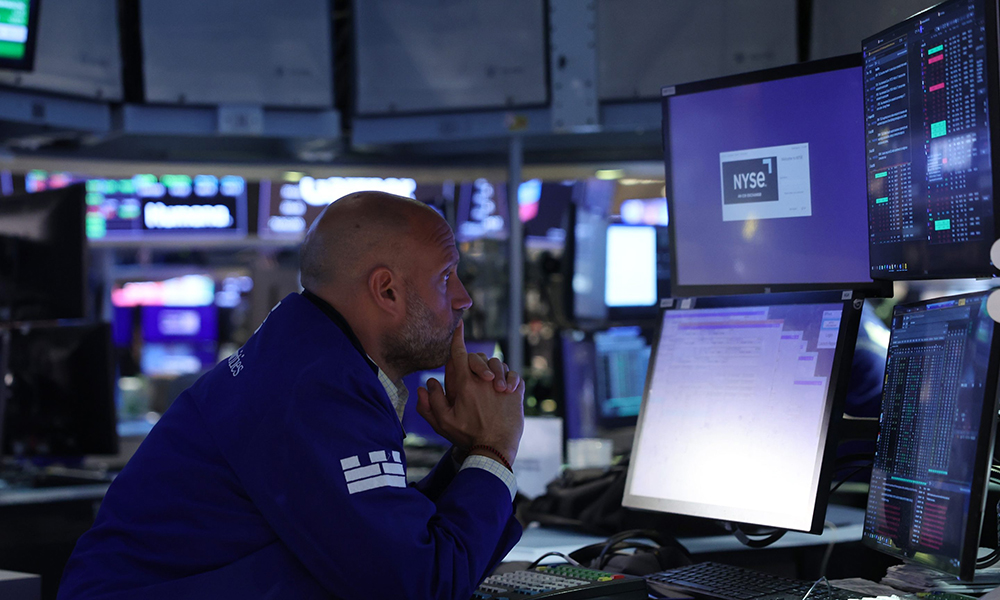
当下显然不乏针对人工智能最新进展的炒作。
自OpenAI的ChatGPT聊天机器人在去年11月声势浩大地推出以来,生成式人工智能初创公司获得了空前的风险投资资金,与这项新技术相关的股票也一路飙升。不过,摩根士丹利(Morgan Stanley)的欧洲专题研究主管爱德华·斯坦利认为,投资者应在“泡沫般的狂喜”中保持耐心。
这位资深分析师和他的同事马蒂亚斯·奥夫鲁姆(Matias Ovrum)最近将当前对人工智能“情绪高涨”的股市与上世纪70次股市泡沫期的股市进行比较,以确定投资者对人工智能应采取的投资策略。
两人都相信人工智能具有长期潜力。事实上,他们周一在一份研究报告中指出,这项技术将“改变各行各业”并成为“未来十年最重要的长期投资主题之一”。但考虑到今年人工智能相关股票的骤涨——尤其是芯片制造商英伟达(Nvidia)的股票今年迄今已飙升近200%——斯坦利和奥夫鲁姆不想对有关估值过高和当前炒作证据的“策略讨论置若罔闻”。
斯坦利说,根据他对以往股市泡沫的研究(包括互联网泡沫和疫情后的“万物皆泡沫”等),投资者今年应该谨慎购买与人工智能挂钩的飞涨的股票。
这位资深分析师在给《财富》杂志的电子邮件评论中写道:“历史表明,对于长期的主题——我们认为人工智能属于这一类——投资者没有必要急于投资。”
从短期来看,人工智能炒作只是一场凯恩斯选美博弈
斯坦利警告称,历史证据表明,尽管人工智能这项底层技术显然具备长期潜力,但其相关股票的短期前景可能不会那么光明。
他指出:“例如,20世纪90年代末,对搜索技术的追捧终于凸显出必要性。然而,投资者本可以等到2003年再进行投资,这样能更了解谁可能成为赢家,而仍然可以获得90%以上的股票涨幅,同时还能得到更多的下行保护。”
在对过去一个世纪出现的股市泡沫的分析中,斯坦利和奥夫鲁姆发现,英伟达和美国大型科技股最近受人工智能热潮推动而上涨的幅度甚至超过了历史泡沫期的平均水平。他们警告道:“如果我们以英伟达或美国大型科技股作为代表来看,从策略上讲,本轮回升应该会出现在最后几个回合。”
在描述近期市场对人工智能的狂热时,摩根士丹利的分析师们引用了英国经济学家约翰·梅纳德·凯恩斯的选美博弈比喻。
在其1936年出版的书籍《就业、利息和货币通论》(The General Theory of Employment, Interest, and Money)的第12章中,凯恩斯描述了一家伦敦报社举办的一场选美大赛,其中参赛者被要求从100张照片中选出最漂亮的女人。这场比赛的妙处在于:所有选中最受欢迎的选项的投票者都将获得现金奖励。
凯恩斯表示,在这类选美比赛中,大多数投票者都不会选择他们个人认为最漂亮的女人。为了赢得现金奖励,他们反而会选择他们认为投票者普遍会觉得最漂亮的女人。他解释说,更精明的投票者甚至可能会更进一步,尝试预料“普遍的人会预测怎样的普遍观点”。
凯恩斯认为,这类从众行为在股市上很常见,是泡沫的成因之一。投资者会纯粹因为认为其他投资者会购买某只股票而购买同一只股票,而不是依据基本面分析做出决策。摩根士丹利的分析师们指出,这项“每年一度的选美博弈”导致了当前的人工智能股市繁荣。
斯坦利对《财富》杂志表示,市场对人工智能股的狂热持续升温,而最近“具影响力的人工智能产品发布”却有所放缓,这意味着投资者今年下半年有必要在战术层面上对该投资主题保持一定的谨慎态度。
从长远来看,人工智能是有潜力的
投资者在短期内无疑应该谨慎投资与人工智能相关的股票,但若从长远来看,情况就不同了。人工智能仍然是这十年里最重要的投资主题。
斯坦利在周一的研究报告中解释道,如今有稳定的“迹象表明消费者和企业对人工智能已经形成‘粘性’,这点与之前的炒作是不同的”,而且开源人工智能模型的采用率也令人惊叹。
自2021年1月以来,在领先的开源人工智能模型库Hugging Face上,排名前100的人工智能模型被下载了35亿次。斯坦利在谈到该数据时表示:“当尝试在这些模型之上创建杀手级应用时,所涉及的试验和错误的广度和深度仍呈指数增长。”
在人工智能技术发展的背景下,为了确定人工智能相关股票的长期潜力,斯坦利和奥夫鲁姆将以往股市泡沫期的股价涨幅与2023年迄今为止温和得多的人工智能指数涨幅进行了比较。
他们解释道,“在股市泡沫见顶前的三年内,股价涨幅中位数为154%左右,平均上涨217%。年初至今,首批人工智能衍生品赢家已经上涨了200%以上,但更大范围的人工智能指数仅温和上涨50%,尚未超过此前在2021年的高点”,并且认为,“目前人工智能的用户粘性和传播广度使其现在的潜力有别于之前的炒作时期。”
斯坦利告诉《财富》杂志,从长期来看,人工智能股票指数的涨幅较过去泡沫期更为温和,这意味着人工智能仍然是“股市中最具吸引力的长期投资主题之一”——投资者只是需要注意投资的时机和对象。(财富中文网)
译者:中慧言-刘嘉欢
当下显然不乏针对人工智能最新进展的炒作。
自OpenAI的ChatGPT聊天机器人在去年11月声势浩大地推出以来,生成式人工智能初创公司获得了空前的风险投资资金,与这项新技术相关的股票也一路飙升。不过,摩根士丹利(Morgan Stanley)的欧洲专题研究主管爱德华·斯坦利认为,投资者应在“泡沫般的狂喜”中保持耐心。
这位资深分析师和他的同事马蒂亚斯·奥夫鲁姆(Matias Ovrum)最近将当前对人工智能“情绪高涨”的股市与上世纪70次股市泡沫期的股市进行比较,以确定投资者对人工智能应采取的投资策略。
两人都相信人工智能具有长期潜力。事实上,他们周一在一份研究报告中指出,这项技术将“改变各行各业”并成为“未来十年最重要的长期投资主题之一”。但考虑到今年人工智能相关股票的骤涨——尤其是芯片制造商英伟达(Nvidia)的股票今年迄今已飙升近200%——斯坦利和奥夫鲁姆不想对有关估值过高和当前炒作证据的“策略讨论置若罔闻”。
斯坦利说,根据他对以往股市泡沫的研究(包括互联网泡沫和疫情后的“万物皆泡沫”等),投资者今年应该谨慎购买与人工智能挂钩的飞涨的股票。
这位资深分析师在给《财富》杂志的电子邮件评论中写道:“历史表明,对于长期的主题——我们认为人工智能属于这一类——投资者没有必要急于投资。”
从短期来看,人工智能炒作只是一场凯恩斯选美博弈
斯坦利警告称,历史证据表明,尽管人工智能这项底层技术显然具备长期潜力,但其相关股票的短期前景可能不会那么光明。
他指出:“例如,20世纪90年代末,对搜索技术的追捧终于凸显出必要性。然而,投资者本可以等到2003年再进行投资,这样能更了解谁可能成为赢家,而仍然可以获得90%以上的股票涨幅,同时还能得到更多的下行保护。”
在对过去一个世纪出现的股市泡沫的分析中,斯坦利和奥夫鲁姆发现,英伟达和美国大型科技股最近受人工智能热潮推动而上涨的幅度甚至超过了历史泡沫期的平均水平。他们警告道:“如果我们以英伟达或美国大型科技股作为代表来看,从策略上讲,本轮回升应该会出现在最后几个回合。”
在描述近期市场对人工智能的狂热时,摩根士丹利的分析师们引用了英国经济学家约翰·梅纳德·凯恩斯的选美博弈比喻。
在其1936年出版的书籍《就业、利息和货币通论》(The General Theory of Employment, Interest, and Money)的第12章中,凯恩斯描述了一家伦敦报社举办的一场选美大赛,其中参赛者被要求从100张照片中选出最漂亮的女人。这场比赛的妙处在于:所有选中最受欢迎的选项的投票者都将获得现金奖励。
凯恩斯表示,在这类选美比赛中,大多数投票者都不会选择他们个人认为最漂亮的女人。为了赢得现金奖励,他们反而会选择他们认为投票者普遍会觉得最漂亮的女人。他解释说,更精明的投票者甚至可能会更进一步,尝试预料“普遍的人会预测怎样的普遍观点”。
凯恩斯认为,这类从众行为在股市上很常见,是泡沫的成因之一。投资者会纯粹因为认为其他投资者会购买某只股票而购买同一只股票,而不是依据基本面分析做出决策。摩根士丹利的分析师们指出,这项“每年一度的选美博弈”导致了当前的人工智能股市繁荣。
斯坦利对《财富》杂志表示,市场对人工智能股的狂热持续升温,而最近“具影响力的人工智能产品发布”却有所放缓,这意味着投资者今年下半年有必要在战术层面上对该投资主题保持一定的谨慎态度。
从长远来看,人工智能是有潜力的
投资者在短期内无疑应该谨慎投资与人工智能相关的股票,但若从长远来看,情况就不同了。人工智能仍然是这十年里最重要的投资主题。
斯坦利在周一的研究报告中解释道,如今有稳定的“迹象表明消费者和企业对人工智能已经形成‘粘性’,这点与之前的炒作是不同的”,而且开源人工智能模型的采用率也令人惊叹。
自2021年1月以来,在领先的开源人工智能模型库Hugging Face上,排名前100的人工智能模型被下载了35亿次。斯坦利在谈到该数据时表示:“当尝试在这些模型之上创建杀手级应用时,所涉及的试验和错误的广度和深度仍呈指数增长。”
在人工智能技术发展的背景下,为了确定人工智能相关股票的长期潜力,斯坦利和奥夫鲁姆将以往股市泡沫期的股价涨幅与2023年迄今为止温和得多的人工智能指数涨幅进行了比较。
他们解释道,“在股市泡沫见顶前的三年内,股价涨幅中位数为154%左右,平均上涨217%。年初至今,首批人工智能衍生品赢家已经上涨了200%以上,但更大范围的人工智能指数仅温和上涨50%,尚未超过此前在2021年的高点”,并且认为,“目前人工智能的用户粘性和传播广度使其现在的潜力有别于之前的炒作时期。”
斯坦利告诉《财富》杂志,从长期来看,人工智能股票指数的涨幅较过去泡沫期更为温和,这意味着人工智能仍然是“股市中最具吸引力的长期投资主题之一”——投资者只是需要注意投资的时机和对象。(财富中文网)
译者:中慧言-刘嘉欢
There’s clearly no shortage of hype surrounding the latest developments in artificial intelligence.
Ever since OpenAI’s ChatGPT chatbot rolled out to great fanfare in November, generative A.I. startups have raked in venture capital money like never before and stocks linked to the new technology have soared. But Edward Stanley, head of thematic research in Europe at Morgan Stanley, believes investors should be patient amid the “bubble-like euphoria.”
The veteran analyst and his colleague Matias Ovrum recently compared the current “excitement” surrounding A.I. with 70 market bubbles over the past century to determine how investors should play the theme.
The pair believe in the long-term potential of A.I. In fact, they argued in a research note on Monday that the technology will be “transformational across industries” and “one of the most prominent secular investment themes over the coming decade.” But given the run-up in A.I.-linked equities this year—most notably chipmaker Nvidia, which has seen its stock soar nearly 200% year to date—Stanley and Ovrum don’t want to be “ignorant to the tactical debates” about elevated valuations and the legs of the current hype cycle.
Based on his research into past market bubbles, including the likes of the dotcom bubble and the post-COVID “everything bubble,” Stanley said that investors should be careful buying high-flying A.I.-linked stocks this year.
“History has shown that for multiyear themes—which we believe this is—there is usually little need for investors to rush in,” the veteran analyst wrote in emailed commentary to Fortune.
In the short term, the A.I. hype is just a Keynesian beauty contest
When it comes to A.I.-linked stocks, Stanley warned, the short-term outlook might not be that bright based on historical evidence, even if the long-term potential of the underlying technology is clearly there.
“Hype around Search in the late 1990s, for example, was ultimately warranted. However, investors could have waited until 2003 to have a better understanding of who the likely winners would be and still capture >90% of the equity upside, and with greater downside protection,” he noted.
In their analysis of market bubbles over the past 100 years, Stanley and Ovrum found that the recent run-up in Nvidia and U.S. large-cap tech stocks owing to A.I. has been even more dramatic than average. “If we use Nvidia or U.S. large-cap tech as the proxy—tactically this rally would be in its later-innings,” they warned.
In describing the recent market euphoria for A.I., the Morgan Stanley analysts pointed to British economist John Maynard Keynes’s beauty contest analogy.
Introduced in chapter 12 of his 1936 book, The General Theory of Employment, Interest, and Money, Keynes described a beauty contest held by a London newspaper in which participants were asked to pick the most beautiful woman from 100 photographs. The wrinkle to the game was this: Any voter who selected the most popular choice would be given a cash reward.
Keynes argued that most voters in this type of beauty contest wouldn’t pick the woman that they, personally, thought was the most beautiful. Instead, hoping to win some cash, they’d pick the woman who they believed the group of voters as a whole would choose as the most beautiful. Or more sophisticated voters might even take things a step further and attempt to anticipate “what average opinion expects the average opinion to be,” he explained.
Keynes believed this type of herding behavior is often seen in markets and is one of the reasons bubbles form. Investors will purchase a stock based purely on their perception that other investors will buy the same stock, instead of any fundamental analysis. Morgan Stanley’s analysts argued this “annual beauty contest” is feeding into the current A.I. stock market boom.
The euphoric rise in A.I. stocks, coupled with a recent slowdown in “needle-moving A.I. product releases,” implies “some tactical caution on the theme by investors is warranted in the second half of the year,” Stanley told Fortune.
Over the long term, it’s got potential
Investors certainly need to be careful over the short term when it comes to A.I.-linked stocks, but over the long term, it’s a different story. A.I. remains the decade’s top investing theme.
In his Monday research note, Stanley explained there are steady “signs of consumer and enterprise ‘stickiness’ versus prior hype cycles” and that user adoption of open-source A.I. models has been impressive.
At the leading repository of open-source A.I. models, Hugging Face, the top 100 models were downloaded 3.5 billion times since January 2021. “The breadth and depth of trial and error in trying to build the killer apps on top of these models is still in the exponential phase,” Stanley said of the data.
To determine the long-term potential of A.I.-linked stocks amid the development of A.I. tech, Stanley and Ovrum compared the past rise of bubbles to the much more modest year-to-date jump of A.I. indexes in 2023.
“Bubbles tend to rally a median 154% in the three years pre-peak; 217% on average. The first derivative A.I. winners have rallied over 200% YTD [year to date], yet broader A.I. indices are up a more modest 50% YTD and not yet above prior 2021 highs,” they explained, arguing that “stickiness and breadth of diffusion set A.I. apart from prior hype cycles.”
Over the long term, Stanley told Fortune, the more modest run-up in A.I. stock indexes versus past bubbles means that A.I. remains “one of the most attractive secular themes in the market”—investors just need to be careful when and where they put their money to work.






